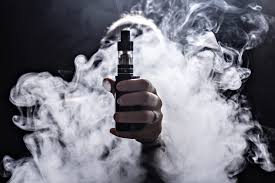Implications of vaping
Mike Alber
Web Editor

E-Cigarettes advertised as an alternative to help smokers quit have taken culture by storm. Now, there are people who vape as a recreational pastime. After all, it’s just vapor and none of those harmful chemicals that cigarettes have, right? But, what are you really putting your lungs through when you vape?
A new study from heath groups and the Centers for Disease Control Prevention has concluded that not only do teens get addicted to nicotine and are more llikely go on to use other tobacco products, but e-cigarettes contain the same harmful toxins and chemicals that can be found in cigarettes as well.
“Nicotine exposure can harm adolescent brain development, which continues into the early to mid-20s,” according to the official CDC website. It continues, “E-cigarette aerosol can contain chemicals that are harmful to the lungs.”
While e-cigs are a safer alternative to cigarettes, which have a mixture of 7,000 chemicals from the smoke of a regular cigarette, the aerosol from e-cigs isn’t free of harmful chemicals.
A professor of pediatrics at the University of California, San Francisco, Dr. Mark L. Rubenstein, conducted a study where he compared the urine and saliva of students on campus who smoked both e-cigarettes and cigarettes, just e-cigarettes and students who don’t smoke. Results came back that teens who smoke e-cigarettes had three times the levels of dangerous chemicals in their body compared to non-smokers.
Even if you don’t use nicotine in e-cigs, the effects are still harmful.
“Rubinstein noted that some of the toxic chemicals were found in the bodies of teens who used flavored e-cigarettes without nicotine,” according to the University of California, San Francisco. It also states, “When they’re heated to the high temperatures required for vaporization, they can produce toxic substances that are potentially carcinogenic.”
As this has been a recent discovery upon research, there hasn’t been much spread about this issue as of yet. Since e-cigs and vapes have become a culturally significant subject matter among campuses across the nation, the pushback from health advocates may fall on deaf ears. There are places that even allow vaping in their facilities and not cigarette smoking, as the advertising campaign over the past decade has left an impact.
“It would make sense that it would cause cancer,” said Austyn Ryan, a Mechanical Engineering major at Hudson Valley. He said he vaped a non-nicotine e-cig once or twice before and now doesn’t vape at all. He also said he has friends who actively vape.
“It’s their life decision,” Ryan said, about his stance on encouraging others to quit or let them be. “I’ll attempt, but it’s really up to them. If I can’t convince them, then there’s no point, really.”
“Teenagers need to be warned that the vapor produced by e-cigarettes is not harmless water vapor, but actually contains some of the same toxic chemicals found in smoke from traditional cigarettes,” Rubenstein stated, through the official UCSF website.
